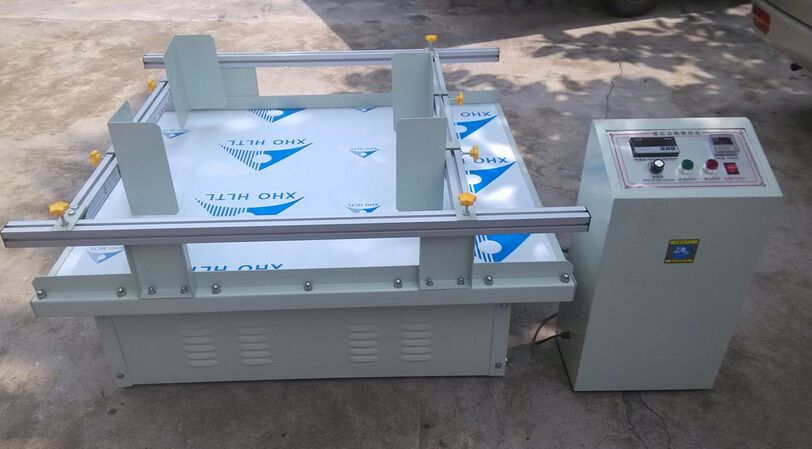ASTM D3580-18 Vibration Test with Rotational Loading
The ASTM D3580-18 vibration test with rotational loading is a critical procedure in the packaging testing sector, designed to evaluate the robustness and durability of packaging materials under simulated transport conditions. This test method provides a means to assess how packaging withstands the combined effects of mechanical vibrations and rotational forces that occur during shipping or handling.
This type of testing is particularly important for ensuring product protection and safety in industries such as pharmaceuticals, electronics, and consumer goods. The ASTM D3580-18 standard specifies the procedure to be followed when performing these tests, ensuring consistency and reliability across laboratories worldwide. The test involves subjecting a sample of packaging material or container to controlled levels of vibration and rotational loading over time.
The importance of this test cannot be overstated in sectors where product integrity is paramount. For instance, pharmaceutical companies rely heavily on proper packaging to protect their products from damage that could compromise efficacy. Similarly, electronics manufacturers need reliable packaging solutions to safeguard delicate components during transit.
The ASTM D3580-18 vibration test with rotational loading helps identify potential weaknesses in the design of packaging systems early in the development process, allowing for improvements before full-scale production. By understanding how various materials perform under these specific conditions, manufacturers can make informed decisions about material selection and structural modifications.
The procedure involves several key steps: setting up the test apparatus according to ASTM D3580-18 specifications; preparing the sample(s) appropriately based on the intended application; applying controlled vibrations and rotational forces; monitoring the performance of each sample throughout the test duration; and finally analyzing results against predefined acceptance criteria.
Given its role in ensuring product safety and compliance with regulatory requirements, this testing method has become an essential tool for quality assurance teams. It allows them to verify that their chosen packaging solutions meet industry standards while also meeting specific client needs related to durability, protection, and overall performance.
Why It Matters
- Ensures product safety by identifying potential issues early in the design phase.
- Helps manufacturers comply with international packaging regulations and standards like ASTM D3580-18.
- Improves efficiency through informed decision-making regarding material selection and structural modifications.
- Safeguards against costly recalls or returns due to product damage during shipping or handling.
The significance of the ASTM D3580-18 vibration test with rotational loading cannot be overstated. It serves as a vital component in maintaining high levels of quality control and compliance within industries reliant on reliable packaging solutions. By leveraging this testing method, companies can enhance their reputation for producing safe, effective products while reducing operational risks associated with poor packaging design.
Scope and Methodology
| Test Parameter | Description |
|---|---|
| Vibration Frequency Range | 0.5 Hz to 100 Hz (adjustable based on specific application) |
| Rotational Speed | Speed range from 0 rpm to 2,000 rpm or higher depending on the apparatus used |
| Test Duration | Duration varies but typically ranges between 1 hour and several days |
| Sampling Methodology | Representative samples are selected from production batches following randomization procedures. |
The ASTM D3580-18 vibration test with rotational loading follows a well-defined set of procedures to ensure accurate results. These include determining the appropriate frequency and amplitude settings for vibrations, setting up the rotational loading parameters according to the specific requirements outlined in the standard, and ensuring that all equipment is calibrated correctly before testing begins.
The process also involves preparing the samples properly, which may involve securing them within a test fixture designed specifically for ASTM D3580-18 compliance. During the actual test run, continuous monitoring ensures adherence to prescribed conditions while recording data points such as acceleration levels and rotation angles at regular intervals.
Quality and Reliability Assurance
- Calibration of all testing equipment prior to each session.
- Strict adherence to ASTM D3580-18 guidelines throughout the entire process.
To maintain high standards of quality and reliability, our lab employs rigorous practices at every stage of the ASTM D3580-18 vibration test with rotational loading procedure. Our team uses state-of-the-art instrumentation calibrated according to international standards (ISO/IEC 17025), ensuring accurate measurements and repeatable results.
Additionally, we follow strict protocols for sample preparation, including proper handling techniques and storage conditions that prevent any degradation before testing begins. This attention to detail ensures consistent performance across all tests conducted here.
In summary, our commitment to quality assurance is reflected not only in the precise execution of ASTM D3580-18 procedures but also in continuous improvement efforts aimed at enhancing both internal processes and external offerings. By adhering strictly to these guidelines, we provide clients with confidence that their products will meet or exceed expectations under real-world conditions.





